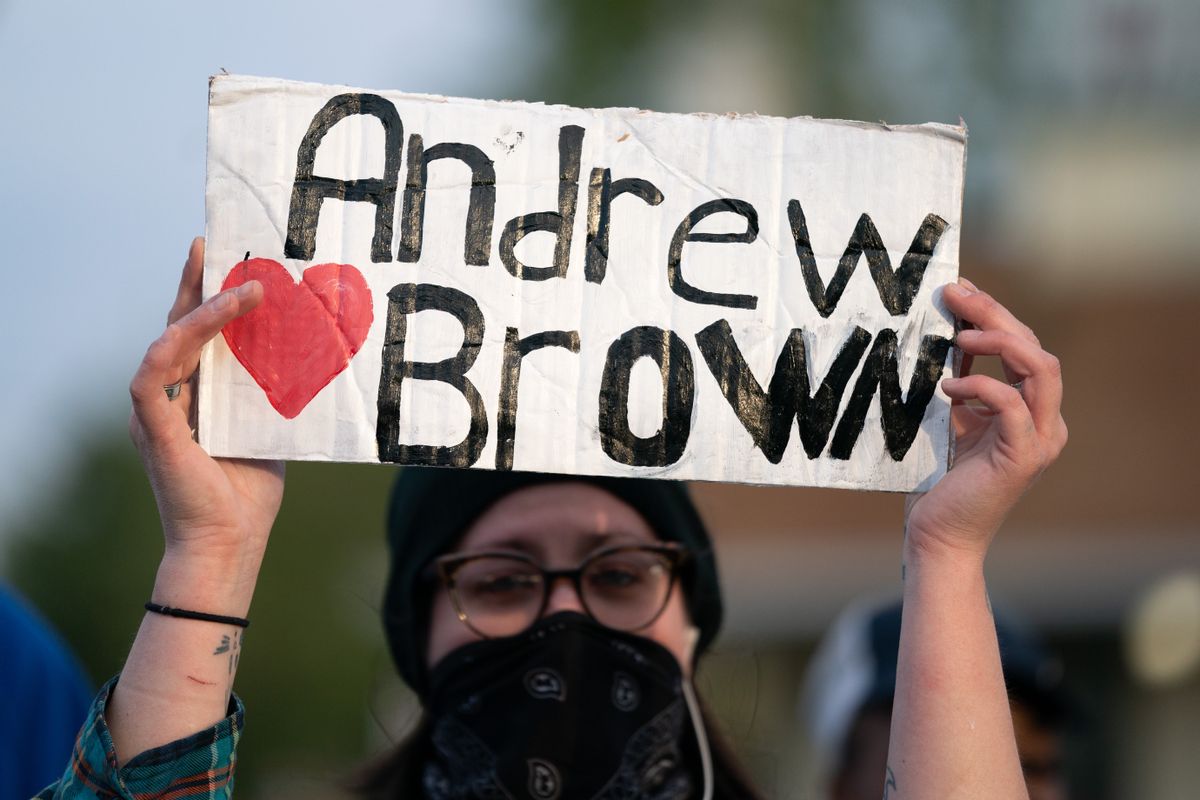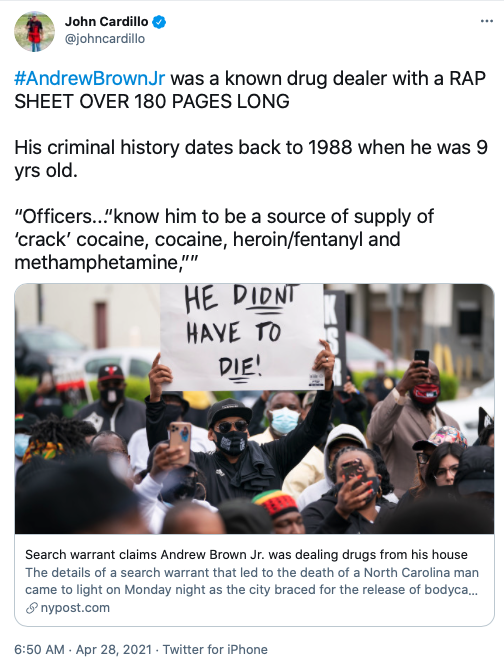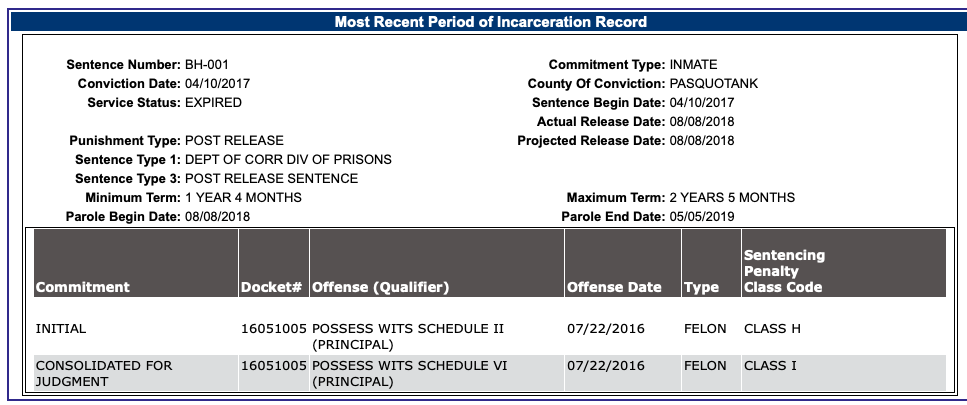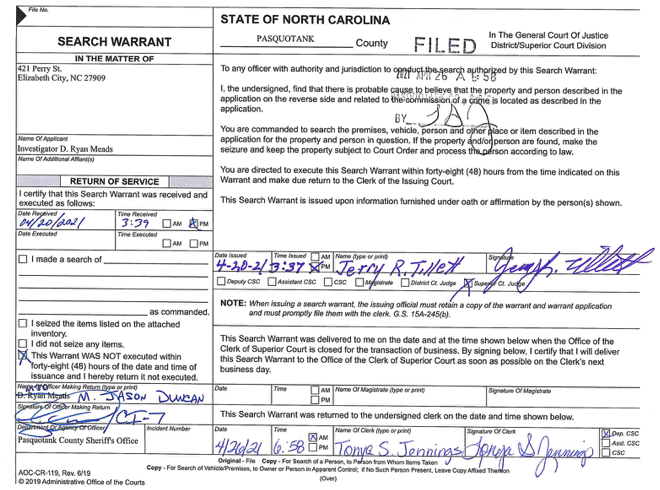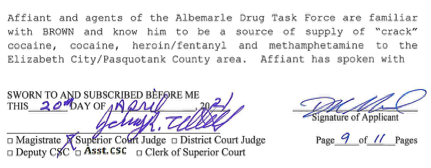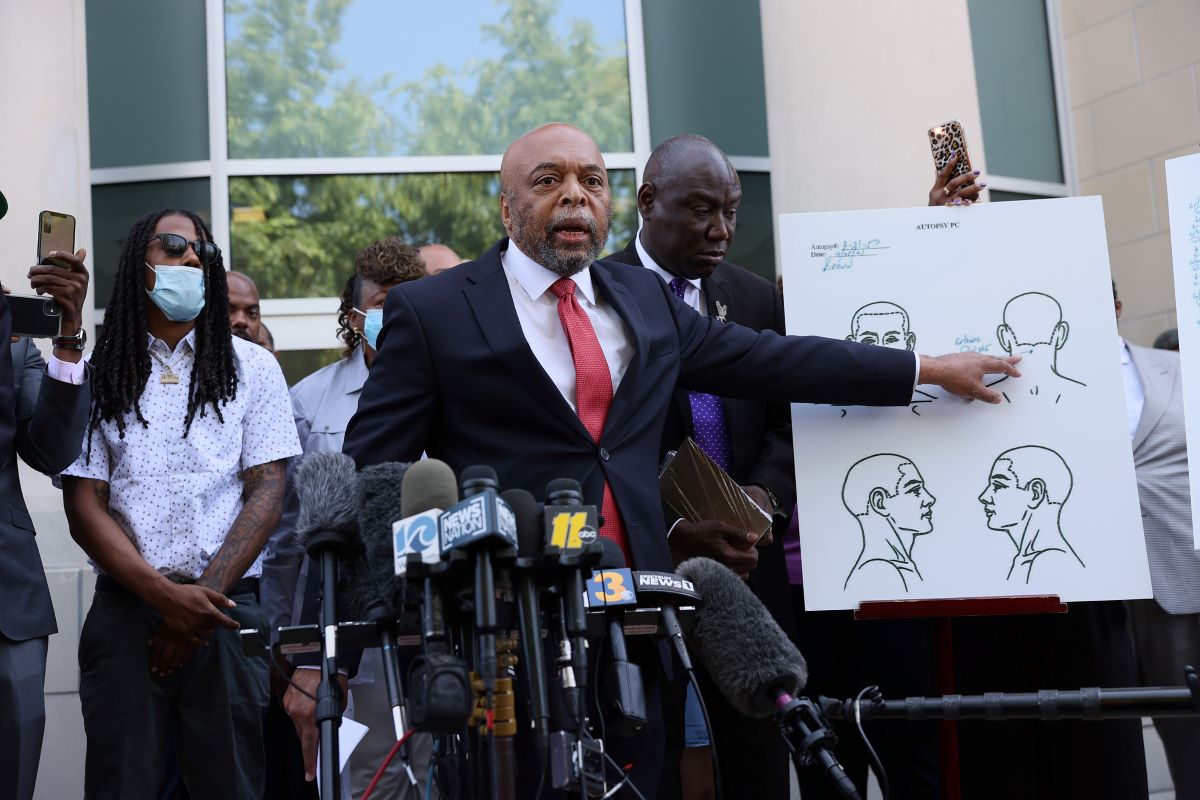On more than a dozen occasions since the late 1990s, authorities in North Carolina's Pasquotank County arrested Brown for offenses that ranged in severity, from driving with a revoked license to intending to sell illegal drugs. At the time of his death, an investigator said officers knew him "to be a source of supply" of such substances for people in the area.
The exact circumstances of Brown's past arrests and incarcerations, including whether he ever sold drugs to children or teens, were unknown at the time of this writing. Also unmeasurable was how many people or entities knew him for selling illicit substances.
On April 21, 2021, North Carolina deputies shot and killed a 42-year-old Black man named Andrew Brown Jr. while serving drug-related search and arrest warrants at his house.
The circumstances that led to the death of Brown, who was known by neighbors as "Drew," remained unclear as of this writing. A judge denied a request to release deputies' body camera video to the public, leaving key questions about his death at the hands of the Pasquotank County Sheriff's Office unanswered.
Meanwhile, sensationalized headlines and social media posts attempted to frame Brown's past arrests and incarcerations as crucial information for understanding — or possibly justifying — the in-custody killing. For example, an April 27 New York Post article alleged "Andrew Brown Jr. was known drug dealer with rap sheet over 180 pages":
Furthermore, while commenting on relatives of Brown's attempts to hold the sheriff's office accountable for his death, former conservative radio host Neal Boortz tweeted that "It's too damn bad Andrew Brown's family wasn't as concerned about him when he was selling drugs to children."
Below we'll review the available evidence to determine the validity of the underlying assertions -- that Brown was a "known drug dealer" in Elizabeth City, a town of roughly 18,000 people northeast of Raleigh, had sold illicit substances to children, and had acquired a criminal record spanning decades.
For this investigation, we sought access to court and police records involving Brown, analyzed news archives, and attempted to reach authorities who supposedly knew him before his fatal encounter with sheriff's deputies.
All in all, the evidence pieced together a complicated life, involving family (Brown left behind seven children of his own and was known for making people laugh at family gatherings) and unavoidable loss and hardship (he was parentless and partially paralyzed on his right side) as well as a series of criminal charges, including some pending felony drug offenses at the time of his death.
What's Brown's Rap Sheet?
On more than a dozen occasions since the late 1990s, authorities had arrested Brown for offenses that ranged in severity from driving with a revoked license to possessing illegal drugs, according to Brown's profile in North Carolina Department of Public Safety's database.
Aside from a misdemeanor assault charge at age 20 (which could involve minor injury or threats to cause harm without following through on them), he was never arrested for threatening violence, attacking anyone, or illegally using firearms.
However, the specific details of Brown's rap sheet, including whether he ever sold drugs to children or teens, remained unknown due to our inability to access evidence such as probable-cause statements. Those records include play-by-play testimonies from arresting officers about why they believe suspects broke the law.
The North Carolina judicial system meets the state's open records law by making such records viewable in-person at county clerk's offices and other places in the state, or by conducting background checks for a fee via limited payment options.
We reached out to the sheriff's office directly for copies of Brown's incident reports or an interview to discuss deputies' interactions with him before his death -- a request that included specific case numbers based on his state offender profile. No one responded to our inquiry, but we will update this report when, or if, that changes.
Here's what we know based on the state's offender database, which only includes cases in which inmates were charged for crimes as adults:
In 1996, authorities arrested 17-year-old Brown for "possessing stolen goods," a misdemeanor crime. Then, about three years later, they detained him again for the simple assault charge.
While he was serving probation for the latter offense at age 20, Brown was caught with what North Carolina law dubs a "Schedule II" drug — substances with a "high potential for abuse" which are only prescribed by physicians with "severe restrictions." That category includes cocaine, opium, morphine, and codeine.
The profile showed prosecutors convicted Brown of a felony, though the type and amount of substances involved remained unknown. (When someone is convicted of a crime while they are already on probation for a previous offense, as in Brown's case, they often face a longer probation sentence, jail or prison time, or fines.)
Over the next several years, authorities cited him for a variety of misdemeanors, including driving with a revoked license, speeding to elude arrest, and trespassing. In 2002, one such stop led to another felony case because law enforcement believed he was intending to deliver or sell drugs, though it was unclear to whom:
Brown went years without legal issues after that. In the mid-2000s, however, Pasquotank County prosecutors cited Brown with the same type of misdemeanor offenses every few months or so (a pattern that indicated law enforcement officers routinely stopped him while driving) and later convicted him of additional drug charges that resulted in prison time.
In April 2017, Brown was incarcerated for the last time. Authorities released him about 14 months later, and he ended his parole for that case in May 2019, records show:
Was Brown a 'Known Drug Dealer'?
In light of the evidence above, yes, Brown had been on the radar of the Pasquotank County Sheriff's Office before an autopsy ordered by his family showed deputies shot him five times, including in the back of his head. Additionally, not long before the killing, an investigator wrote in a court document that law enforcement knew Brown "to be a source of supply" of drugs for people in the area.
Let us unpack that evidence. On April 20, 2021, within moments of a jury's convicting former Minneapolis police officer Derek Chauvin of murdering George Floyd, Superior Court Judge Jerry Tillett issued a warrant for investigators to search Brown's home and car for narcotics.
In other words, the paperwork authorized Investigator Ryan Meads of the sheriff's office to coordinate a plan for officers to seize drugs and other evidence such as cell phone data that could prove law enforcement's theories about Brown. Additionally, Sheriff Tommy Wooten said deputies, including a tactical unit, had arrest warrants out for Brown on suspicion of drug-related charges:
The sheriff's office made those plans after a buyer of Brown's agreed to detail his alleged experience of getting drugs from Brown. That person, whose gender and identity remained unknown, told investigators that they often met up at Brown's house or hotels to buy cocaine, "crack" cocaine, heroin, and meth, according to the search warrant.
On two separate occasions in March 2021, investigators working for an interagency drug task force recorded audio and video of that type of transaction with the source's help.
In conclusion, the document stated: "[Meads] and agents of the Albemarle Drug Task Force are familiar with Brown and know him to be a source of supply of 'crack' cocaine, cocaine, heroin/fentanyl and methamphetamine to the Elizabeth City/Pasquotank County area":
What Happened When Deputies Killed Brown?
Not much was confirmed at the time of this writing about why deputies fired their guns while executing the search and arrest warrants on Brown.
An eyewitness told reporters that deputies fired at Brown multiple times as he was in the driver's seat of his car, and that that vehicle skidded out of his yard and eventually hit a tree. Wooten, the sheriff, said that the entire encounter lasted 20 seconds and placed a handful of deputies on administrative leave.
Only Brown's relatives, attorneys for the family, and prosecutors have seen body-camera footage to help discern the facts of the case. (Judge Jeffery Foster denied a request to release the video publicly, citing ongoing investigations by the North Carolina State Bureau of Investigation and FBI.) And those parties have had differing interpretations of what the footage shows.
Chantel Cherry-Lassiter, of the Southern Coalition for Social Justice, for example, told The Associated Press (AP) that she heard gunfire from the instant the video played, as Brown was parked in the driveway with his hands on the steering wheel. She told the AP Brown tried backing up the vehicle only after deputies ran up to it firing their guns. (We reached out to Cherry-Lassiter, as well as to lawyer Ben Crump, for our own interview, and we will update this report if they respond to our requests.)
Alternatively, District Attorney Andrew Womble, who also viewed the footage, said it showed Brown's car making “contact” with law enforcement twice before they opened fire, according to AP:
Relatives described Brown as a proud father who pushed his children to finish school even though he dropped out himself. One of his children, Khalil Ferebee, told The Virginian-Pilot that he was at his father's house the day Brown was killed.
“No matter what his past reflects, it still doesn’t give him (the deputy) the right to shoot him, period,” long-time friend Daniel Bowser told the AP.
Why Do People Highlight Past Arrests of Black Men Who Die at the Hands of Law Enforcement?
It's common for people to look for incriminating facts about Black men killed by police, no matter what relevance those details have to their deaths.
For example, shortly after a Dallas police officer fatally shot Botham Jean, 26, because she mistook Jean's apartment for her own in fall 2018, tweets attempted to shape Jean's image by reporting authorities found a small amount weed inside his home.
Days after Chauvin killed Floyd at a Minneapolis convenience store in May 2020, the former leader of that city's police federation issued a statement criticizing anyone who was not focusing on the past arrests of the 46-year-old Floyd. (Here's what's true and false about Floyd's alleged offenses before his fatal encounter with Chauvin.)
Or, after Atlanta police officers fatally shot Rayshard Brooks, 27, in a Wendy's parking lot less than one month later, social media users circulated posts saying his past arrests and incarcerations were crucial for justifying why police killed him. (Here's our investigation into those claims about Brooks.) The following year, the same phenomenon surfaced online again when another white Minnesota police officer fatally shot 20-year-old Daunte Wright. (This is our page with the facts on that case.)
In many cases, the memes and selfie-style videos of firebrand commentators detailing the accusations against the shooting victims are often exaggerated or misleading accounts of the deceased’s history with the U.S. criminal justice system, commonly omitting context to enhance prosecutors’ allegations.
According to psychologists and scholars of structural racism, the strategy of trying to shift the public narrative onto the criminal histories of Black men killed by law enforcement (moving people's focus away from the circumstances of their death) is an attempt to invalidate or negate their killings as well as justify law enforcement's actions.
Snopes considered a 2016 study that analyzed the language used by news media and high-profile figures about Black men killed by police the previous year. One of its authors, CalvinJohn Smiley, Ph. D., an assistant professor in sociology at Hunter College-City University of New York, sent us this email on the subject:
In American society, we tend to want to believe that a person has to be a 'perfect victim' in order to gain sympathy. Otherwise, empathy is not afforded and they can be posthumously criminalized further ... Interestingly, I would say unlike Black figures and leaders who are often vilified in life (e.g., Malcolm X or Martin Luther King, Jr.) that are then sanitized in death, we are seeing the opposite occur. Black men with records, some very trivial, are magnified in a way that puts the criminal record before the person. I have to believe this is by design, not an accident.
